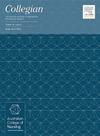澳大利亚和新西兰的土著居民,托雷斯海峡岛民和Māori护理和助产学术人员
IF 1.7
4区 医学
Q2 NURSING
引用次数: 0
摘要
促进土著居民、托雷斯海峡岛民和Māori护理和助产学术人员的代表性和支持性产业是澳大利亚和新西兰奥特罗阿大学的一项关键宗旨,也是加强卫生人力的基础。令人惊讶的是,关于这个劳动力的信息是未知的。这项研究的目的是为了了解土著居民、托雷斯海峡岛民和Māori护理和助产学术人员。方法横断面研究采用在线调查的组织,提供认可的护理和助产教育在澳大利亚和新西兰。收集了与土著居民、托雷斯海峡岛民和Māori护理和助产人员有关的人口、学术和就业信息。调查结果33家机构回应了调查,总共报告了55名员工。新西兰各大学(n = 6)有1至4名Māori或土著工作人员。澳大利亚大学(27所)报告有1至9名土著和托雷斯海峡岛民员工,其中10所大学报告没有。大多数员工拥有博士或硕士学位,并在全职持续职位中担任讲师级别的工作。有10人被任命为教授级别的职位。工作量主要分配给教学和研究。这两个国家都没有达到与原住民,托雷斯海峡岛民和Māori总人口相当的水平。需要作出巨大努力来增加这一劳动力。此外,由于大多数工作人员担任较低级别的学术职位,迫切需要通过增加指导和专业发展来加强继任计划。本文章由计算机程序翻译,如有差异,请以英文原文为准。
Aboriginal, Torres Strait Islander and Māori nursing and midwifery academic workforce across Australia and Aotearoa New Zealand
Background
Promoting a representative and supportive industry for Aboriginal, Torres Strait Islander and Māori nursing and midwifery academic staff is a key tenet of Australian and Aotearoa New Zealand universities, and fundamental to strengthening the health workforce. Surprisingly, information about this workforce is unknown.
Aim
The aim of the study was to gain an understanding of the Aboriginal, Torres Strait Islander and Māori nursing and midwifery academic workforce.
Methods
A cross-sectional study was conducted using an online survey of organisations that provide accredited nursing and midwifery education within Australia and Aotearoa New Zealand. Demographic, academic and employment information relating to Aboriginal, Torres Strait Islander and Māori nursing and midwifery staff was collected.
Findings
Thirty-three organisations responded, reporting a total of 55 staff. Aotearoa New Zealand universities (n = 6) had between one and four Māori or Aboriginal staff members. Australian universities (n = 27) reported between one and nine Aboriginal and Torres Strait Islander staff, with 10 universities reporting that they had none. Most staff held a PhD or Master’s degree and were employed at lecturer level in a full-time continuing position. There were 10 appointed into a professoriate level position. Workload was predominantly allocated to teaching and research.
Discussion
Neither country has reached parity with the Aboriginal, Torres Strait Islander and Māori overall population. Substantial efforts are required to grow this workforce. In addition, as most staff hold lower-level academic positions, greater succession planning through increased mentorship and professional development is urgently needed.
求助全文
通过发布文献求助,成功后即可免费获取论文全文。
去求助
来源期刊

Collegian
NURSING-
CiteScore
2.70
自引率
6.70%
发文量
127
审稿时长
72 days
期刊介绍:
Collegian: The Australian Journal of Nursing Practice, Scholarship and Research is the official journal of Australian College of Nursing (ACN).
The journal aims to reflect the broad interests of nurses and the nursing profession, and to challenge nurses on emerging areas of interest. It publishes research articles and scholarly discussion of nursing practice, policy and professional issues.
Papers published in the journal are peer reviewed by a double blind process using reviewers who meet high standards of academic and clinical expertise. Invited papers that contribute to nursing knowledge and debate are published at the discretion of the Editor.
The journal, online only from 2016, is available to members of ACN and also by separate subscription.
ACN believes that each and every nurse in Australia should have the opportunity to grow their career through quality education, and further our profession through representation. ACN is the voice of influence, providing the nursing expertise and experience required when government and key stakeholders are deciding the future of health.
 求助内容:
求助内容: 应助结果提醒方式:
应助结果提醒方式:


